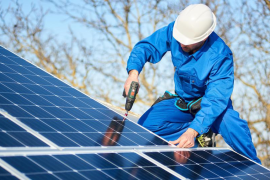A government report published in 2020 stated that more than 970,000 homes in the UK have solar panels. There is an influx in home solar systems due to the price dropping by 25% since 2014, so it has never been cheaper to buy domestic solar panels.
Unfortunately, there are currently no solar panel grants or schemes for free solar panels in the UK. However, on the 1st January 2020, a UK government-backed initiative called the Smart Export Guarantee (SEG) was launched. The SEG requires some electric companies to pay small-scale energy generators for low carbon electricity they export back to the National Grid.
Some feel now is a great time to invest in solar power through solar panels installed on your home or other means, such as buying clean energy stocks. Continue reading to learn more about solar panels in the UK.
Is It Still Worth Getting Solar Panels In The UK?
Yes, there are still many advantages to getting solar panels installed in the UK, even though there are no free solar panel schemes open at the moment. Back in 2010, there was the Feed-in Tariff when companies would pretty much buy solar panels for you. They would install the panels for you, allow you to benefit from the energy bill savings, and they would earn money from the Feed-in Tariff. For the first few years, this was an excellent incentive for generating renewable energy, but in 2016 the 64% reduction in payments damaged the Feed-in Tariff initiative. In 2019 it was eventually shut down.
The UK government also offered interest-free loans and grants to encourage solar panel installation as part of the Green Deal. However, in 2015, the Green Deal came to an end. This was primarily due to what the government described as a lack of interest by homeowners.
If you cannot afford the total upfront cost of a brand new solar PV (photovoltaic) system, there are ways to source the additional money. Some companies offer homeowners low-interest loans and affordable repayment schedules to help them make the switch to solar. You might also be able to get a loan from your bank to cover some of the solar panel installation costs. In addition, the majority of banks offer personal loans specifically for home improvements, which could be applied to domestic renewable energy systems.
Introduction to Smart Export Guarantee (SEG)
The Smart Export Guarantee (SEG) has been set up in the hope that it helps fill the hole that the Feed-in Tariff left behind. However, one of the significant differences is that instead of being based on payments from the government, the SEG ensures that energy suppliers pay homeowners for any surplus solar-generated electricity that has been fed back into the National Grid.
Ofgem was responsible for setting the rates with the Feed-in Tariff. With the SEG, the government has permitted the energy suppliers to determine their own prices. With the energy market being competitive, it should lead to companies outbidding each other with higher repayment rates. This will result in homeowners getting better deals on the renewable energy they sell back.
The SEG incentive is also being viewed as much fairer than the Feed-in Tariff. The UK government used to pay homeowners 50% of their unused solar-generated electricity. This was the case even if households were exporting as much as 80% of their electricity back to the grid. With the SEG in position, energy suppliers pay the homeowner for every single bit of electricity they send their way. The process is made much simpler if your home is fitted with a smart meter, so it is worth looking into this whilst installing your solar panels.
Homeowners with solar panels in the UK are now benefiting from 100% of their solar panels with the SEG in place. The solar-generated electricity which is used by the household will contribute to savings on energy bills. According to Energy Saving Trust (EST), this could save you up to £330 per year. Any unused solar-generated electricity is transferred over to the National Grid. It is then bought by an energy supplier, with several suppliers paying around 5.5p kilowatt-hour. According to the EST, a 4 kilowatt-hour solar PV system could generate around £94 per year on a 5.5-kilowatt-hour SEG tariff.
If you want to get the most of your solar panels, it is best to combine them with a solar battery. This will create a solar-plus-storage system and stock up the electricity generated during the day. You can then use the stored energy in the evenings or when the system is not generating at optimum capacity.
Closing Thoughts
Solar panels will give you electricity independence. You will rely less on energy suppliers, so you won’t have to rely on their pricing. You may still need to buy a bit of electricity from the central grid, but with the storage capability of a solar battery, you have the potential to be entirely off the grid.





